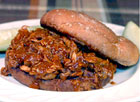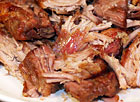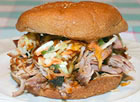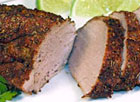Seasoned Roasted Pork Shoulder
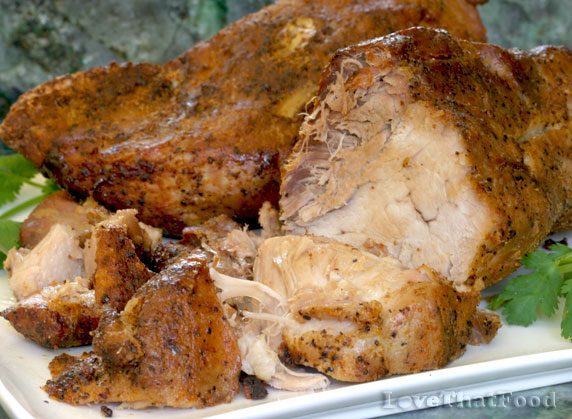
Yield: 4 lbs. (how pork is served will determine how many servings there will be)
Cook Time: 3 hours
Tips: Roast pork with fat side up. If pork doesn't have much fat, add about 1/2 inch of water in drip pan to help prevent pork from losing moisture during roasting.
Suggestion: Delicious served sliced, chunked or shredded and wrapped in any number of tortilla dishes, such as tacos, tostadas, fajitas, burritos, taquitos, enchiladas or even over tortilla chips topped with shredded cheese (and with sides such as salsa, sour cream, sliced pickled jalapenos, etc.) as nachos!
Whether you like to call it pork shoulder or pork butt, the bottom line is (no pun intended), when you rub your pork roast with a great combination of herbs and seasonings and let it roast slowly in the oven (or on your outdoor grill or smoker), you end up with a spectular, tender and juicy mouth-watering experience that no one will forget! Pork shoulder can be purchased with the option of bone in or boneless, and you might find it labeled as pork shoulder, pork butt, pork shoulder butt, or even as bone-in or boneless pork shoulder picnic roast. Which cut you choose depends on your own personal taste or how you plan to serve the pork. There are plenty of pork shoulder recipes out there, most of them using the oven roasting method or the outdoor grilling (and sometimes smoking) method. Whichever cooking method you use, one thing for sure - it is well worth the wait!
Whether outdoor grilling, smoking or oven-roasting, the trick to a tender and juicy pork shoulder (or pork butt) roast is to cook it slowly. Leaving the fat on your roast (rather than trimming it off) and cooking your pork with the fat side
facing up is also another trick to producing a moist and flavorful roast. When the roast is placed in the oven with the fat side up, the pork fat will drip down into the meat and moisten and flavor it as it cooks. Though not all recipes call for this final tip, placing about 1/2 inch of water in the drip pan (or in an aluminum pan below the grilling rack beside the hot coals if you're using the outdoor grilling method) will also help the pork roast to retain its moisture. Pork shoulder roasts with less fat are more likely to dry out during cooking than those that have areas with fat attached to the meat. In short, if you're cooking a lean roast with little fat content, it might be a good idea to add some water to the drip pan. You should check the water a couple times during roasting, and add a little more water if necessary. You can also occasionally baste the pork roast with its own drippings while roasting to help prevent it from drying out, as long as the drippings are still in liquid form and are not dried and leaning on the burned side. If the pork roast has enough fat, however, these extra steps shouldn't be necessary.
How you season your pork roast is completely up to you. One of the beautiful things about pork shoulder is that it not only tastes amazing on its own (served as a roast), it is fabulous in pulled pork form (shredded after it has been cooked, usually with a couple forks). Pulled pork can be served with a variety of dishes that use tortillas, such as tacos, tostadas, fajitas, burritos, enchiladas, taquitos and even over crunchy tortilla chips as pork nachos! (Of course, if using this pork with nachos, you'll probably want to top it with shredded cheese and serve it with sides of salsa, sour cream, avocado slices, pickled jalapeno slices, etc.)
Whether outdoor grilling, smoking or oven-roasting, the trick to a tender and juicy pork shoulder (or pork butt) roast is to cook it slowly. Leaving the fat on your roast (rather than trimming it off) and cooking your pork with the fat side
How you season your pork roast is completely up to you. One of the beautiful things about pork shoulder is that it not only tastes amazing on its own (served as a roast), it is fabulous in pulled pork form (shredded after it has been cooked, usually with a couple forks). Pulled pork can be served with a variety of dishes that use tortillas, such as tacos, tostadas, fajitas, burritos, enchiladas, taquitos and even over crunchy tortilla chips as pork nachos! (Of course, if using this pork with nachos, you'll probably want to top it with shredded cheese and serve it with sides of salsa, sour cream, avocado slices, pickled jalapeno slices, etc.)
Recipe▼
Ingredients
- 1 boneless pork shoulder (or butt) (about 4 lbs.)
- 4 cloves garlic, smashed
- 2 tablespoons fresh oregano
- 2 tablespoons coarse salt (Kosher or sea salt)
- 1 tablespoon coarsely ground black pepper
- 1/4 teaspoon cayenne pepper
- 1/4 teaspoon paprika
- 1 teaspoon cumin
- 2 teaspoons chili powder
- 3 tablespoons olive oil (or vegetable oil)
- 3 tablespoons white wine vinegar (or apple cider vinegar)
Directions
Place pork shoulder on a work surface. Pierce small slits in pork in several areas with a sharp knife (this will help the pork rub to penetrate the meat).
In a small mixing bowl, combine garlic, oregano, salt, black pepper, cayenne pepper, paprika, cumin, chili powder, oil and vinegar. Whisk until combined, then rub all over pork shoulder, making sure some of the rub gets into the incisions. (Note: The salt will help to pull out the moisture from the pork, which will help to form a nice crust on the outside when roasted.) Place pork shoulder in a plastic bag, scooping up any remaining rub and adding it to the bag. Tie the bag in a tight non-leaking knot and place in the refrigerator (knot-side-up) for 3 hours or overnight.
When ready to roast pork shoulder, preheat oven to 350° F. While oven is preheating, remove the pork shoulder from the refrigerator and allow to sit at room temperature. When oven is ready, place pork in oven on a roasting rack or broiler pan that sits on top of a drip pan. Roast pork, uncovered, for about 3 hours or until skin appears crispy-brown. Remove from oven and allow to sit on a cutting board for 10 minutes before slicing, chunking or shredding. See "Suggestions" above for serving ideas.
In a small mixing bowl, combine garlic, oregano, salt, black pepper, cayenne pepper, paprika, cumin, chili powder, oil and vinegar. Whisk until combined, then rub all over pork shoulder, making sure some of the rub gets into the incisions. (Note: The salt will help to pull out the moisture from the pork, which will help to form a nice crust on the outside when roasted.) Place pork shoulder in a plastic bag, scooping up any remaining rub and adding it to the bag. Tie the bag in a tight non-leaking knot and place in the refrigerator (knot-side-up) for 3 hours or overnight.
When ready to roast pork shoulder, preheat oven to 350° F. While oven is preheating, remove the pork shoulder from the refrigerator and allow to sit at room temperature. When oven is ready, place pork in oven on a roasting rack or broiler pan that sits on top of a drip pan. Roast pork, uncovered, for about 3 hours or until skin appears crispy-brown. Remove from oven and allow to sit on a cutting board for 10 minutes before slicing, chunking or shredding. See "Suggestions" above for serving ideas.


